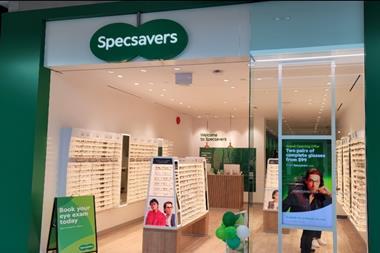It was better than feared
Contrary to the Scrooges’ pessimistic predictions, Christmas was not, on the whole, a bloodbath. Granted, there have been casualties and like-for-like sales were down 3.3 per cent according to the BRC’s retail sales monitor, so it wasn’t particularly good, but as Retail Knowledge Bank senior partner Robert Clark says: “The fact is, retail sales didn’t generally fall off a cliff. Most people still have a job, mortgage payments for many have gone down and people had presents to buy.” But OC&C associate partner Tom Gladstone adds that the true picture will emerge when profit figures are released. “The amount of discounting will have affected margins,” he says.
A nerve-wracking run-up
Festive trading may have been slightly better than expected but make no bones about it, retailers had to work extremely hard to get those results. Because December 25 fell on a Thursday, many people took the days before as holiday and had the best part of a week to shop. And who could blame them for leaving it late, given that retailers were slashing prices by the day? The bargain hunt resulted in heavy footfall in the last few days before Christmas and the first few days after. As Verdict Consulting director Neil Saunders says: “Gains were made very late in the day.”
Winners and losers
“Tough market conditions bring out the strong players,” says Gladstone. When consumers deliberate over purchases more, it can result in a gaping schism between the winners and losers. PricewaterhouseCoopers UK retail and consumer leader Mark Hudson says: “People have a limited amount of money to spend so they go where they feel they will get better prices, better product and better service. They shop around more.” Clark believes this gap will widen and that retailers’ performances will become polarised between the best and weakest.
The value message paid off
Shoppers value value. It comes as no surprise that Christmas shoppers flocked to value players such as Peacocks, Matalan and Primark. However, Saunders also points out that retailers such as Morrisons and Sainsbury’s, which communicated a strong value message, also enjoyed buoyant sales. “They pushed that message in such a way consumers felt they were getting quality for a good price.” In contrast, sales of Marks & Spencer food – with its reputation for high prices – suffered a 5.2 per cent fall in like-for-likes.
Net gains for online
Asos, Game, Play.com, Shop Direct, Ocado, the list goes on. This year, OC&C placed online retailers in a separate table because their retail sales are not a fair comparison with store like-for-likes. Viewing them in one list, their strength becomes even more apparent. But without wanting to dampen spirits, Grant Thornton head of retail services David Bush points out that online growth has slowed. IMRG December online sales figures were up 14.2 per cent, but the previous year they soared more than 50 per cent. Even the seemingly untouchable world of online is not immune to tough trading.
Super for supermarkets
Festive cheer all round was aided by the fact consumers feel that the grocers’ non-food offer provides value for money. Although the UK press has made much of the fact that Tesco posted the weakest sales of all the supermarket chains, it still achieved a 2.5 per cent like-for-like increase while having the highest sales in the industry. Gladstone says: “All the grocers have been able to demonstrate value. That’s not necessarily about the cheapest food, but about good quality for a good price.” However, it should be noted that the supermarkets were aided by inflation.
Middle market misery
Some of those retailers languishing at the bottom of the table highlight how it has never been tougher for the middle market, which is particularly susceptible to the changing shopping habits of cash-strapped families. Saunders says: “They’re the old guard of the high street and it’s now very difficult to get growth in the middle market.” M&S and Next are proof that this sector is suffering. But, adds Saunders: “Although Next’s like-for-likes and overall growth were bad, it hasn’t dropped a lot in terms of profitability because it has managed margins well.”
No time for treats
It wasn’t a time for treats. M&S’s decline in food sales is just one indicator of shoppers’ determination to save money. Elsewhere, Thorntons’ sales slipped, as did Majestic Wine’s as shoppers resisted champagne and fine wine. And while to date the luxury market has been more resilient in the spending downturn, there are signs of change. Luxury jewellery retailer Theo Fennell was hit hard as like-for-like sales dropped 21 per cent over 13 weeks and Burberry reported a 3 per cent drop on the back of strong trading statements to date.
The kids are alright
Younger shoppers are spending steadfastly even if their parents aren’t and it turned out to be a very good Christmas for New Look, JD Sports, Blue Inc, Asos and Republic. Mothercare’s solid Christmas performance also suggests that parents still spent money on their children. When it came to themselves, however, they resisted temptation, as other fashion brands aimed at older shoppers, such as Jacques Vert and Alexon, experienced a fall in like-for-likes.
Still room for surprises
Among them was Debenhams, where sales were surprisingly robust when many expected them to nosedive. Saunders says: “To have positive growth with like-for-likes slipping only slightly is a very good performance. They’ve done a lot with their stores and they’ve improved their ranges.” Meanwhile in the much-troubled big-ticket sector, Comet’s like-for-likes fell only 2.5 per cent while DSGi’s slumped 12 per cent. This might reflect Comet’s investment in customer service and its wide product range owing to a greater proportion of larger stores than rival DSGi.
A note of caution
Store closures will have affected results. Some might be surprised, for instance, to see Jessops edging towards the top of the list with a like-for-like sales increase of 3.1 per cent, despite poor sales and a profit warning last year. But the camera specialist has shut its poorly performing stores, so that must be factored into its figures. Furthermore, adds Clark, it can be tricky to compare one retailer with another when companies such as Waitrose and Peacocks reveal results based on a two-week trading period, while Next’s, for instance, is based on 21 weeks.
Looking ahead
Heavy discounting saved the day for many retailers over Christmas, but Hudson warns they will have to be far more careful this year. “Trading will continue to be difficult and so margins will become far thinner,” he says. Gladstone adds that shoppers’ perception of price will be vital. “They have to believe they’re getting a good product for the price they’re paying,” he says. And this year’s festive results prove more than ever that a strong multichannel presence is crucial to success. But retailers can take solace in the fact that no matter how bad it might seem in the run-up to Christmas 2009, the City will always say it’s going to be worse.


























No comments yet